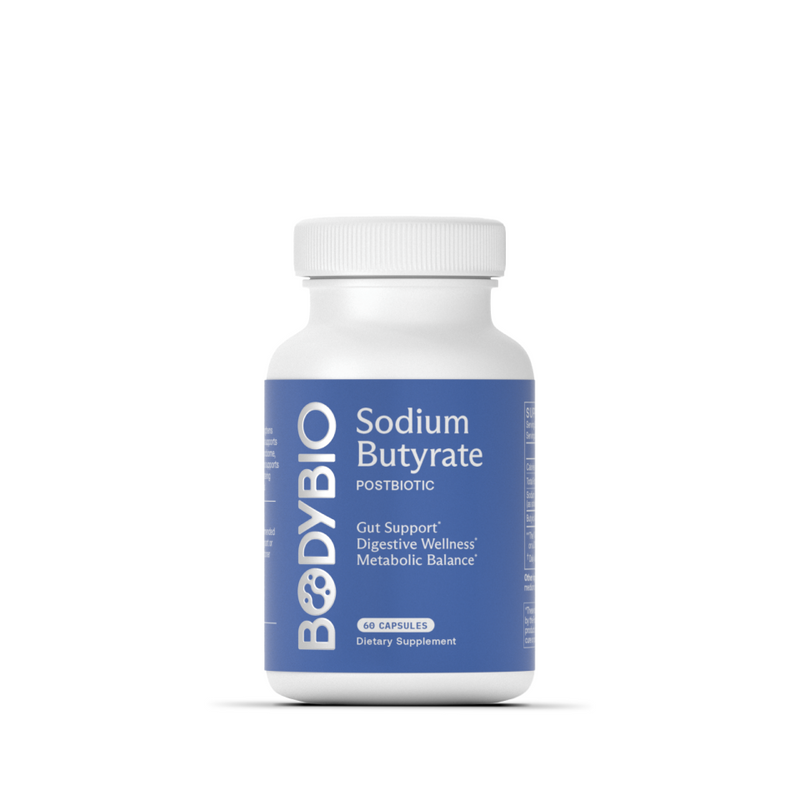The Gut-Skin Axis: How Your Gut Health Impacts Breakouts and Aging Skin
Authors:

Ashley Palmer
Nutritional Therapy Practitioner, Health & Wellness Expert
Key Takeaways:
If your skincare routine isn't delivering the results you hoped for, the real issue might lie on a deeper level, within your gut. The gut and skin are connected through complex pathways involving immune signals, microbial metabolites from the gut microbiome, and inflammation. Disruptions in gut health can alter how your skin functions and repairs itself, often showing up as breakouts, dryness, or premature aging. However, addressing this internal imbalance may be the key to achieving clearer, more resilient skin.
Table of Contents:
What Is the Gut-Skin Axis?
The gut-skin axis is a complex, two-way communication network between the gut microbiome and the skin. This connection is mediated by immune signaling, metabolic byproducts (compounds created by gut bacteria during digestion that can influence inflammation and skin health), and nervous system pathways. When the gut microbiome is diverse and balanced, it helps regulate systemic inflammation, produce beneficial metabolites, and support immune function — all of which are key to skin health.
On the other hand, gut dysbiosis — an imbalance in the microbiome — can send distress signals to the skin via the bloodstream, often manifesting as acne, dryness, or accelerated aging. These signals include pro-inflammatory cytokines, hormone metabolites, and toxins that escape through a leaky gut and disrupt the skin barrier.
Why the Gut-Skin Axis is Key for Skin Clarity and Resilience
The gut plays a vital role in detoxification, immune modulation, and inflammation control. All three of these processes are directly tied to how our skin looks and feels. When gut health is compromised, it can reduce the skin's ability to defend against environmental stressors, heal breakouts, and maintain hydration and elasticity. As a result, symptoms like adult acne, rosacea, dullness, and premature wrinkles may start to emerge.
How Gut Health Affects Hormones and Triggers Breakouts
Many skin issues don't start on the surface — they sneakily originate in the gut. When the digestive system is out of balance, it can set off a cascade of immune and hormonal disruptions that lead to breakouts. This section explores how inflammation and hormone metabolism, both influenced by gut health, contribute to adult acne and skin congestion.
Inflammation and Sebum Dysregulation
One of the most common ways gut imbalance affects the skin is through chronic, low-grade inflammation. A disrupted microbiome can elevate systemic inflammation, which may increase sebum production (an oily, waxy substance produced by glands in the skin), clog pores, and create an environment conducive to acne-causing bacteria. Even individuals who didn't struggle with acne in adolescence may start experiencing breakouts as adults due to this internal inflammatory load.
Gut Imbalances and Hormonal Influence
The gut also plays a major role in hormone metabolism. Estrogen, for example, is processed and eliminated through the digestive system. If the gut is not functioning optimally, excess estrogen may recirculate in the body, contributing to hormonal acne. Similarly, poor gut health can influence insulin sensitivity and blood sugar regulation, other key players in acne development.
The Gut's Role in Premature Skin Aging
Skin aging doesn't just start with crow's feet — it often begins in the gut. Long before visible signs appear, shifts in the microbiome, gut lining integrity, and nutrient absorption can influence how your skin repairs itself and resists aging. By exploring these lesser-known pathways, we can better understand how supporting the gut might be one of the most effective strategies for preserving youthful skin.
Collagen Breakdown and Barrier Damage
Chronic inflammation and gut permeability — often called "leaky gut" — can accelerate collagen degradation and weaken the skin barrier. When tight junctions in the intestinal lining become compromised, inflammatory molecules and toxins can enter the bloodstream and impact the skin, breaking down collagen and impairing skin structure. This can lead to fine lines, wrinkles, and a loss of firmness over time.
Nutrient Absorption and Skin Vitality
Key nutrients absorbed in the gut that directly impact skin health include:
|
Nutrient |
Role in Skin Health |
|
Vitamin C |
Boosts collagen production |
|
Supports wound healing and reduces redness |
|
|
Antioxidants |
Protect skin from oxidative damage |
|
Amino Acids |
Serve as building blocks for skin structure |
Many of the nutrients essential for glowing, youthful skin are absorbed in the gut. These include vitamin C (important for collagen production), zinc (anti-inflammatory), and antioxidants (which neutralize free radicals). If the gut lining is inflamed or damaged, it may struggle to absorb these nutrients, leaving the skin nutrient-deprived and more vulnerable to premature aging.
Key Mechanisms: From Inflammation to Collagen Breakdown
While individual symptoms like redness or wrinkles may seem isolated to the skin, they often stem from deeper physiological processes in the gut. This section takes a closer look at two key internal mechanisms — cytokine signaling and intestinal permeability — that link gut inflammation to accelerated skin aging and barrier dysfunction.
Cytokine Signaling and Oxidative Stress
When the gut is inflamed, it releases cytokines — small proteins that act as messengers in the immune system. These cytokines can circulate systemically, reaching the skin and promoting oxidative stress, which damages collagen and accelerates visible aging. This cascade effect not only impacts skin texture but also contributes to redness, sensitivity, and slow healing.
Tight Junctions and Systemic Effects
Proteins like zonulin and occludin are essential to maintaining the integrity of the intestinal barrier. When these proteins are downregulated due to stress, infection, or poor diet, the gut lining becomes permeable. This can lead to an increase in circulating endotoxins and inflammatory mediators that damage the skin and disrupt its barrier function, making it more prone to irritation, dryness, and aging.
Microbiome Metabolites and Anti-Aging Benefits
Growing clinical evidence suggests that gut-derived compounds directly influence skin function. A 2023 review in Metabolites highlights how short-chain fatty acids (SCFAs), such as butyrate, regulate immune responses and help maintain skin health by reducing systemic inflammation. Probiotic supplementation can also improve skin hydration, elasticity, and barrier integrity — key signs of youthful skin — according to a recent study on probiotics' effects on skin.
Butyrate, SCFAs, and Skin Resilience
Short-chain fatty acids (SCFAs) like butyrate are among the most powerful gut-derived compounds supporting skin health. Produced by beneficial bacteria during the fermentation of fiber, butyrate has potent anti-inflammatory properties and supports intestinal barrier integrity. Research shows that butyrate may help regulate immune responses and support collagen synthesis, making it a key player in anti-aging from within.*
Microbiome Diversity as a Fountain of Youth
A diverse gut microbiome is associated with better metabolic and immune health, and it may play a foundational role in long-term skin vitality. Greater microbial diversity can lead to improved hydration, reduced breakouts, and more balanced inflammation throughout the body. Fortunately, positive diet and lifestyle changes can quickly shift the gut microbiome toward a healthier state.
How to Support the Gut-Skin Axis for Clearer, Younger Skin
Supporting the gut-skin axis isn't just about adding probiotics or eliminating certain foods. It's about consistently nurturing the internal systems that influence your skin's ability to regenerate, protect, and glow. In this section, we'll break down the specific nutrients, foods, and daily habits that can help your gut thrive, and in turn, reflect that vitality through your skin.
Nutrients and Foods to Prioritize for the Gut-Skin Axis
The most skin-supportive gut foods are those that reduce inflammation, encourage microbial diversity, and support collagen production. These include:
- Omega-3, 6, and 9 fatty acids (nuts, seeds, olive oil, and wild salmon)
- Resistant starch (cooked and cooled rice, whole grains, legumes, and green bananas)
- Fiber-rich prebiotics (onions, garlic, asparagus)
- Fermented foods (sauerkraut, kefir, kimchi)
- Antioxidant-rich vegetables and berries
- Collagen-supportive nutrients like vitamin C, zinc, and amino acids
These foods work together to nourish the gut lining, promote beneficial bacteria, and supply the building blocks your skin needs to stay strong and supple.
Lifestyle strategies to support the gut-skin axis:
- Prioritize 7–9 hours of quality sleep per night
- Reduce stress through mindfulness, meditation, or walking outdoors
- Stay active with regular, moderate exercise
- Limit ultra-processed foods and added sugars
- Strategic supplementation can promote microbial balance and help maintain skin hydration and elasticity
In addition to nutrition, lifestyle factors can make a big impact on the gut-skin connection. Regular sleep, stress reduction (through mindfulness, movement, or nature exposure), and physical activity all promote a healthier microbiome. If you're unsure where to start, gut microbiome testing can offer valuable insights into your current gut health and guide a more targeted approach.
The Gut-Skin Axis: A Foundational Approach to Radiant Skin
The gut-skin axis may be one of the most underappreciated drivers of skin health. Factors like microbial balance, nutrient absorption, and immune signaling in the gut all play essential roles in how our skin looks and functions. From breakouts to fine lines, many skin concerns reflect deeper systemic imbalances, often starting in the gut.
Thankfully, supporting your gut-skin axis doesn't have to be complicated. By integrating anti-inflammatory foods, diverse plant fibers, essential fatty acids, and proven supplements, you can help your body restore balance and radiance from within.
Support the gut-skin axis — BodyBio Butyrate helps support gut repair and a healthy inflammation response that can impact skin aging and complexion.*


